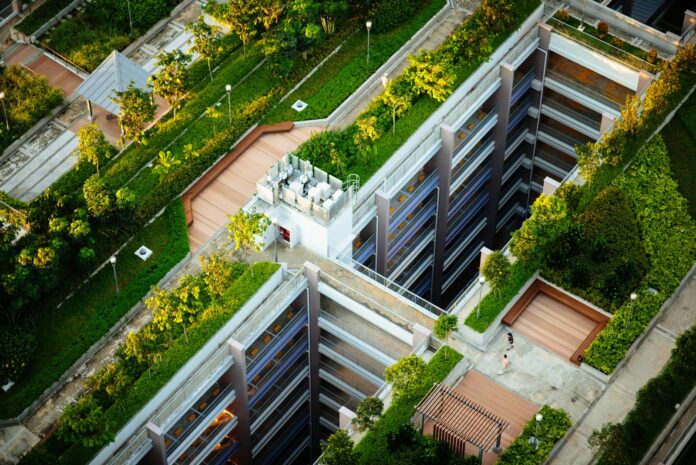Urbanization presents numerous challenges, including increased pollution, reduced green spaces, and heightened energy consumption. Amidst these challenges, green roofs have emerged as a sustainable solution with the potential to transform urban environments.
Introduction to Green Roofs: A Sustainable Urban Solution
Green roofs, also known as vegetated or living roofs, are building rooftops partially or completely covered with vegetation, soil, and a waterproof membrane. These innovative structures provide a range of ecological benefits, transforming otherwise unused spaces into thriving ecosystems. The concept of green roofing dates back centuries, but modern advancements have made their implementation more feasible and effective in urban settings.
The primary components of a green roof include a root barrier, drainage layer, growing medium, and plant layer. These elements work together to support plant life while protecting the building structure. Green roofs can be classified into extensive and intensive types, with extensive green roofs being lightweight and low-maintenance, and intensive green roofs featuring deeper soil and a wider variety of plants, often resembling traditional gardens.
As cities grapple with the adverse effects of urbanization, green roofs offer a sustainable solution by enhancing urban biodiversity, improving air quality, and mitigating the urban heat island effect. By integrating green roofs into urban planning, cities can create more resilient and livable environments, addressing both ecological and social needs.
Environmental and Economic Benefits of Green Roofs
One of the most significant environmental benefits of green roofs is their ability to reduce stormwater runoff. Traditional rooftops contribute to urban flooding by channeling rainwater directly into drainage systems. In contrast, green roofs absorb and retain rainwater, reducing the burden on municipal drainage systems and lowering the risk of flooding. This absorption also helps filter pollutants from the water, improving overall water quality.
Green roofs also play a crucial role in mitigating the urban heat island effect, a phenomenon where urban areas experience higher temperatures than their rural counterparts due to human activities and infrastructure. The vegetation on green roofs provides natural insulation, reducing the need for air conditioning and lowering energy consumption. This not only leads to cost savings for building owners but also reduces greenhouse gas emissions, contributing to climate change mitigation efforts.
Economically, green roofs can increase property values and extend the lifespan of roofing materials by protecting them from extreme weather conditions and UV radiation. Additionally, green roofs create opportunities for urban agriculture, allowing residents to grow food locally and reducing the carbon footprint associated with transporting produce. These economic benefits, combined with the environmental advantages, make green roofs a compelling investment for urban areas.
Challenges and Future Prospects for Green Roof Implementation
Despite their numerous benefits, the widespread adoption of green roofs faces several challenges. The initial cost of installation can be prohibitive for some property owners, especially when compared to traditional roofing materials. Furthermore, the structural integrity of existing buildings must be assessed to ensure they can support the additional weight of a green roof, which may require costly modifications.
Maintenance is another consideration, as green roofs require regular upkeep to ensure the health of the vegetation and the functionality of the drainage systems. This includes tasks such as weeding, watering, and replacing plants as needed. While extensive green roofs are designed to be low-maintenance, they still require some level of care, which can be a deterrent for potential adopters.
Looking ahead, the future prospects for green roof implementation are promising, driven by increasing awareness of environmental issues and advancements in green roofing technology. Incentive programs and subsidies from local governments can help offset the initial costs, making green roofs more accessible to a wider range of property owners. Additionally, ongoing research and innovation in materials and design are likely to reduce maintenance requirements and enhance the overall efficiency of green roofs. As urban areas continue to seek sustainable solutions, green roofs are poised to play a pivotal role in creating healthier, more resilient cities.
